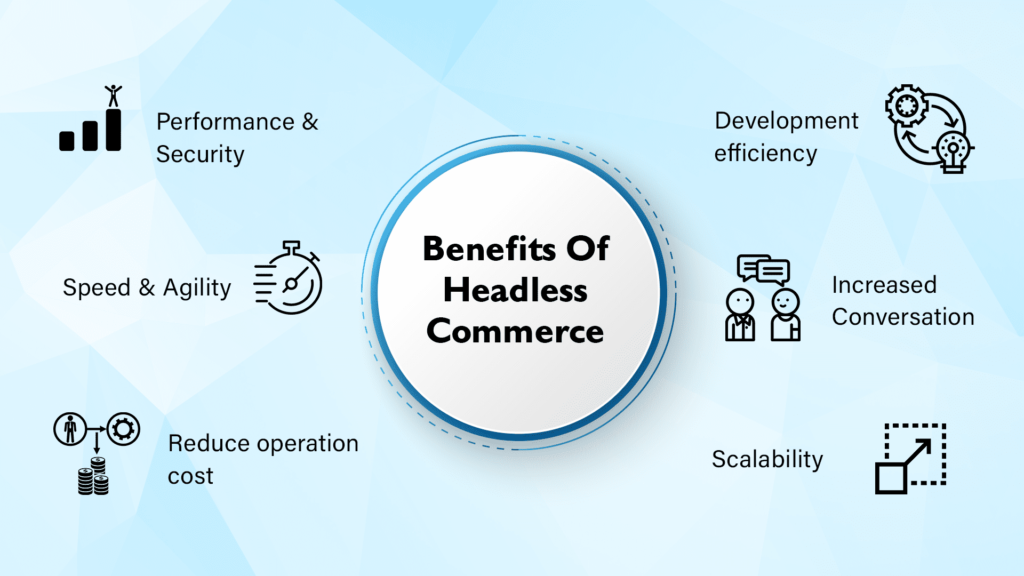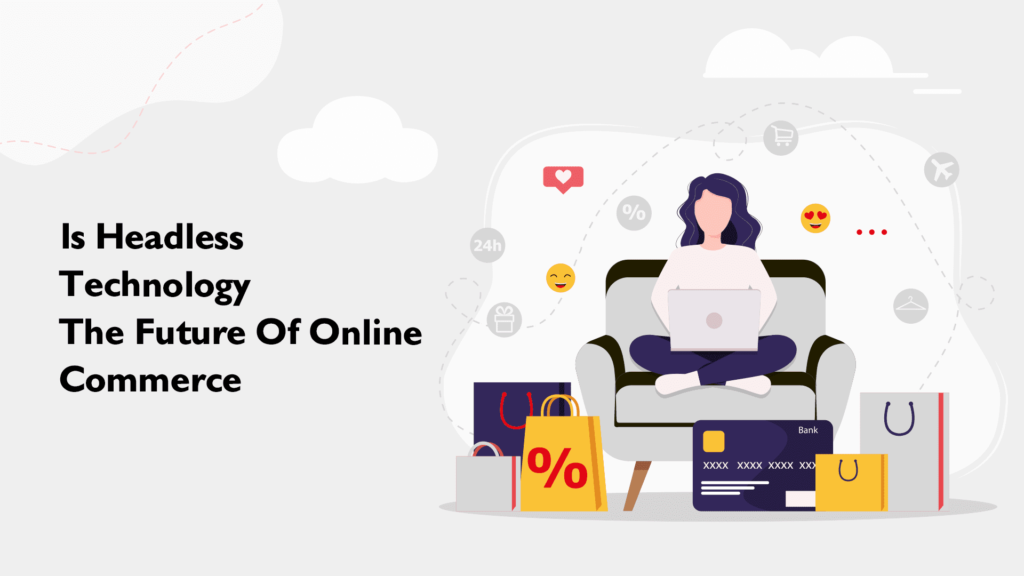In this article, we will explore the benefits of Headless Commerce and the major considerations businesses need to take into account before adopting this approach.
Headless Ecommerce has become a buzzword in the world of eCommerce due to its flexible and scalable approach to designing an online store. By separating the frontend and backend components, merchants can create a customized user experience and innovate quickly without disrupting backend processes.
“Headless” is the future of retail commerce. Getting your products online is no longer just a dream for small business owners; it is now a reality. However, keeping your products online is only the first step towards success.
To achieve it, you must ensure that your customers can find your products quickly. The idea is to create a faster, leaner, and more agile e-commerce site. This blog will explore this trend, dive deep into the benefits of headless commerce, and demonstrate how it can help your online business grow.
What Does Headless Commerce Mean?
Headless commerce is an eCommerce architecture where the front-end and back-end systems are separated. This means that the front-end can be built with any technology and is not limited by the back-end.
APIs are commonly used to develop headless commerce architectures, while JavaScript frameworks like React or Angular are used to create the front-end experience. The back-end systems are implemented using a microservices architecture, with each service being separate and then linked using an API gateway.
Adopting a headless commerce approach allows for a more flexible and scalable eCommerce platform. It also enables a better user experience as the front-end can be customized to meet specific requirements.
Visit Here: Is Headless Ecommerce Solutions Right For Your Business?

Benefits Of Headless Commerce
Many marketers are interested in to know the benefits of headless commerce, but some may not be fully aware of all its advantages.
Headless commerce is a revolutionary approach that separates the front-end and back-end of an e-commerce store. Simply put, it decouples the presentation layer or the user interface from the back-end, enabling more flexibility and customization.
Here are some of the benefits of headless commerce that make it the future of e-commerce:
1. Flexibility
Headless commerce enables merchants to independently customize the frontend of their online store without affecting the backend processes. This provides them with the freedom to make changes to the user interface, incorporate new features, and experiment with different designs. Furthermore, benefits of headless commerce also permits businesses to utilize multiple frontend frameworks concurrently, providing them with greater flexibility when it comes to design and enhancing the user experience.
2. Ability to adapt
Headless commerce offers greater flexibility compared to traditional e-commerce platforms. Unlike traditional platforms that are limited by built-in features, headless commerce allows you to use any programming language or framework to build the front-end of your e-commerce platform. This gives you the freedom to design a truly custom e-commerce experience for your customers.
3. Scalability
Benefits of headless commerce is an incredibly scalable approach that separates the frontend and backend components. By doing so, merchants can add new features or scale up the frontend without affecting the backend processes. This ensures that online stores can manage a high volume of traffic and transactions while maintaining optimal user experience and performance.
4. Faster Page Loading
Headless commerce has the potential to enhance page loading speed, which plays a crucial role in enhancing user experience and SEO. By separating the frontend and backend components, headless commerce reduces the time taken by the browser to load the page, leading to faster loading times. Additionally, this separation allows businesses to optimize the code for better performance, further improving page loading speed.
5. Customized User Experience
Headless commerce allows businesses to tailor their user experience to their brand identity and values. By selecting the frontend technology stack, merchants can design a unique user interface that caters to their requirements. Furthermore, utilizing customer data to personalize the user experience can boost engagement and conversion rates.
6. Integration with Third-Party Services
Major benefits of headless commerce simplifies the process of integrating with third-party services like payment gateways, shipping providers, and marketing automation tools. With this approach, merchants can select the most suitable third-party services to meet their requirements and integrate them smoothly into their online store. This facilitates the smooth running of business operations, reduces manual work, and enhances overall efficiency.
7. Reduced Development Time and Costs
An effective way to decrease development time and costs by separating frontend and backend components the benefits of headless commerce. Merchants can develop both independently, resulting in significant savings in time and development costs. Moreover, they can reuse the same backend for various frontend applications, eliminating the need to rebuild the backend for each new project.
8. Improved SEO
Headless commerce has the potential to enhance SEO by enabling businesses to optimize their frontend code for better search engine rankings. This approach allows merchants to choose a frontend technology stack that is SEO-friendly and optimize the code for better performance. As a result, page load time can be improved, bounce rates can be reduced, and organic traffic can be increased. Additionally, headless commerce benefits enables businesses to create SEO-friendly URLs, meta tags, and structured data, which can further improve their search engine rankings.
9. Enhanced Security
Headless commerce is an innovative approach that can significantly enhance the security of online stores. By separating the frontend and backend components, sensitive data such as customer information, payment details, or order history is stored separately, thus reducing the risk of data breaches. With headless commerce, businesses can choose the most appropriate security measures for each component, ensuring that their online store is secure and compliant with industry standards. Overall, headless commerce is an effective way to protect your customers’ data and your business reputation.
10. Future-Proof
Forward-thinking solution that can easily adjust to evolving business needs and technologies with the benefits of headless commerce. Merchants have the flexibility to select the most suitable frontend technology stack that aligns with their requirements and is also compatible with future updates. Additionally, they can incorporate new features or modify the user interface without interfering with the backend processes. This guarantees that their online store stays current and competitive.
11. Seamless Omnichannel Experience
Headless Commerce offers a significant advantage of providing a seamless omnichannel experience. By separating the front-end from the back-end, businesses can effortlessly deliver a consistent shopping experience across various channels, such as mobile apps, social media platforms, and IoT devices. This ensures that customers can smoothly transition from one channel to another without any disruption in their shopping journey. For instance, a customer may begin exploring products on a mobile app and then conclude the purchase on a desktop computer.
Overall, these benefits of headless commerce can help businesses improve their e-commerce capabilities, increase customer engagement and loyalty, and stay competitive in a rapidly changing marketplace.
Visit Here: How does Headless Ecommerce Help To Succeed In Business?
Tips for Businesses Considering a Switch to Headless Ecommerce
Although headless commerce offers several advantages, businesses must also consider certain critical factors before adopting this new technology. Apart from the benefits of headless commerce, below are some of the major considerations to keep in mind when implementing headless commerce:
- Evaluate Your Business Needs: Prior to transitioning to headless commerce, businesses should assess their specific business requirements. Headless commerce may not be the ideal solution for every business. Companies that offer basic product offerings and do not require advanced functionality may not gain much advantage from adopting a headless commerce approach.
- Technical Expertise: Implementing and managing headless commerce requires technical expertise. To successfully adopt this approach, businesses need to have a skilled team with knowledge of APIs, microservices, and other technical skills.
- Integration Challenges: To implement headless commerce successfully, it is crucial for businesses to integrate their e-commerce platform with multiple systems and tools. Therefore, businesses must ensure that their platform is capable of seamless integration with different systems.
- Cost: Although there are several benefits of headless commerce, it can be more expensive than traditional e-commerce platforms. Thus, businesses should carefully evaluate the costs involved in implementing and maintaining a headless commerce platform before making a decision.
- Time and Resources: Implementing a headless commerce platform can require more time and resources compared to a traditional e-commerce platform. Therefore, businesses should make sure they possess the essential resources to effectively implement and manage a headless commerce platform.
The Importance of Considering Headless Commerce Benefits with it’s Major Considerations
Apart from the benefits of headless commerce, when it comes to running a successful business, several major considerations must be taken into account. These considerations include but are not limited to, market research, customer needs, and competition. By carefully considering these factors, businesses can make informed decisions that can lead to increased profitability and growth.
- Market Research – Market research is a critical consideration for any business. It involves gathering and analyzing data on consumer behavior, preferences, and trends. By conducting market research, businesses can gain valuable insights into their target market and develop products and services that meet their customers’ needs. This can help businesses stay ahead of their competition and maintain their position in the market.
- Customer Needs – Understanding customer needs is another major consideration for businesses. By identifying the needs of their customers, businesses can tailor their products and services to meet those needs. This aids to achieve high levels of customer satisfaction, loyalty, and repeat business. It can also help businesses attract new customers who are looking for products and services that meet their specific needs.
- Competition – Finally, businesses must consider their competition when making decisions. By analyzing their competitors’ strengths and weaknesses, businesses can identify areas where they can improve their own operations. This can help businesses stay competitive and maintain their market share.
Headless Ecommerce Benefits With It’s Technical Considerations
Rather than benefits of headless commerce, there are also some technical considerations that businesses need to take into account when adopting headless commerce. Here are some of the technical considerations for headless ecommerce benefits:
- API Management – API management is critical for headless commerce. Businesses need to ensure that their APIs are secure, reliable, and scalable.
- Microservices Architecture – Microservices architecture is a key component of headless commerce. Businesses need to ensure that their e-commerce platform is designed with microservices architecture in mind.
- Cloud Hosting – Headless commerce platforms are often hosted on the cloud. Businesses need to ensure that they have a cloud hosting provider that is reliable, scalable, and secure.
Visit Here: Top 5 Benefits of Headless Commerce Solution

Future of Headless Commerce in the E-commerce Industry
Headless commerce is a relatively new concept in the e-commerce industry, but it is quickly gaining popularity. Headless commerce refers to the separation of the front-end user interface from the back-end e-commerce platform. This allows businesses to create customized front-end experiences for their customers while still using a robust and reliable e-commerce platform.
Visit Here: Headless commerce is the future of e-commerce
Conclusion
Headless commerce is a game-changer for online businesses looking to improve their user experience, performance, and scalability. By separating the frontend and backend components, merchants can customize their online store, add new features, and integrate with third-party services without disrupting the backend processes. Benefits of Headless commerce, including improved SEO, enhanced security, and future-proofing. If you are looking to take your online business to the next level, Webnexs headless commerce is definitely worth considering.
Frequently Asked Questions(FAQs)
Will headless commerce benefit from allowing for more customization and personalization?
You can only use templates and themes for the frontend of many monolithic platforms. A headless solution makes it much simpler to build those creative visions of your designer without running into limitations if you want to have a custom experience that incorporates your own brand’s distinctive look and feel.
Is it possible for your developer to use any programming language or framework with headless commerce?
Headless commerce allows your developer to build using any language or framework they are most comfortable with, unlike some traditional eCommerce platforms that impose a particular programming language.
Are you sure, will Headless commerce improve your time to value?
The amount of time and money needed to create thorough business logic and back end services is the most crucial factor to take into account when creating custom software.
Should you consider a headless commerce platform?
Depending on what you’re looking for, the traditional system will work if your business does not need to be present across a wide range of channels.
Can customized b2b headless commerce solutions lower the cost of customer acquisition?
Headless commerce will help to lower it. Businesses are constantly vying for mindshare while also dealing with rising customer acquisition costs.
Would breaking the conventional e-commerce architecture bring any big results?
It takes business courage to abandon the plain old system and embrace the transformation of headless trading. This has less to do with potential cross-platforming issues; more related to fear of the unknown.
Who are those businesses that have used the benefits of headless commerce?
Larger development and IT teams, then international selling needs with multiple websites are the major businesses that result in neat scaling.

